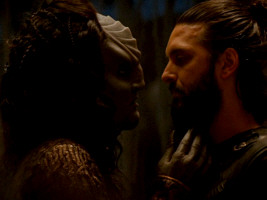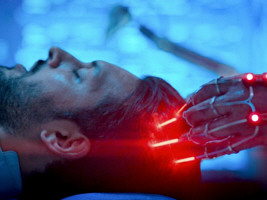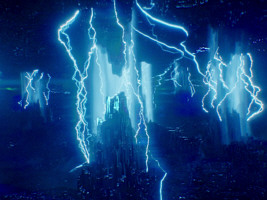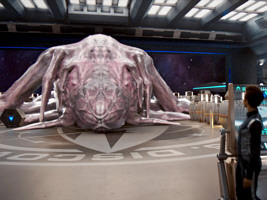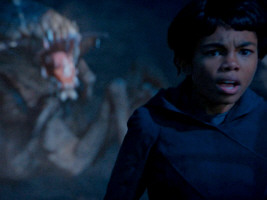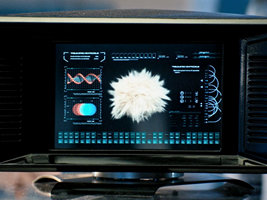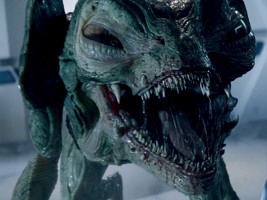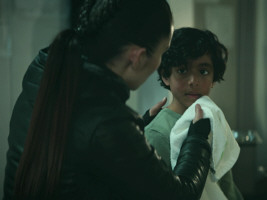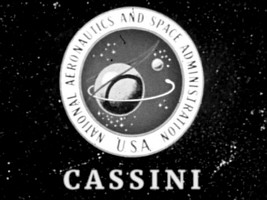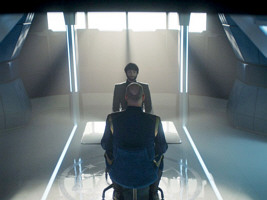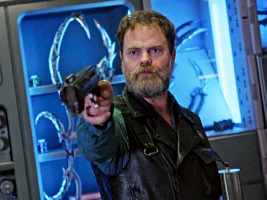Discoverse Continuity Problems
Unexplained Discontinuities"Classified" Facts and Technologies
 Even if we leave aside the general visual disconnection of the two series from most of the rest of Star Trek, there are numerous continuity problems in Star Trek Discovery and also in Strange New Worlds. Discovery's Season 2 attempted to explain some of them but created new issues in the course. Note that I don't claim that all of the issues listed in the following are irreconcilable.
Even if we leave aside the general visual disconnection of the two series from most of the rest of Star Trek, there are numerous continuity problems in Star Trek Discovery and also in Strange New Worlds. Discovery's Season 2 attempted to explain some of them but created new issues in the course. Note that I don't claim that all of the issues listed in the following are irreconcilable.
Unexplained Discontinuities
These are continuity issues of the Discoverse that were not amended or alleviated in a way to better comply with the rest of Star Trek.
Klingons
- Augment Klingons as we know them from TOS and ENT's fourth season never show up in Discovery. If we suppose that Discovery-style Klingons are identical to TMP Klingons, per the "visual reboot" principle, then the more human-looking Augments don't exist in the Discoverse (or it would need a very good on-screen explanation why they have temporarily gone into hiding).
- Discovery Klingons had no hair in DIS season 1. After these "new" Klingons (that were created on Bryan Fuller's behest) were not well received by many viewers, their look was revised for season 2. While the totally different anatomy remained the same, they were given back their hair to be more relatable. In the attempt of a retcon, having no hair was explained on screen in DIS: "Point of Light" as a tradition in wartime. All Klingons of the different houses of Discovery, however, had no hair even before T'Kuvma made the surprising appeal to go to war against the Federation. Klingon children had no hair in T'Kuvma's flashback, and Mirror Voq was hairless as well. Perhaps the political changes brought about by L'Rell are a reason why Klingons grow hair again and never give up this custom after Discovery. But this conflicts with the uninterrupted continuity of classic "hairy" Klingons (with the sole exception of General Chang that proves the rule), and quite paradoxically Discovery posits that the Klingons have totally conformist traditions at a time when they are explicitly said and shown to be totally divided. So even if we put up with the other visual discrepancies, bald Klingons remain an isolated and ultimately unexplained oddity of Discovery.
- Discovery Klingons have pointed ears, which invalidates the story of TNG: "Birthright II" where the Romulan-like shape of her ears sets apart the half-Romulan Ba'el.
- It seems unlikely that Discovery Klingons are sexually and/or genetically compatible with other species, such as humans or Romulans. Quite possibly B'Elanna or Ba'el can't exist in the Discoverse. The two penises of male Klingons (DIS: "Will You Take My Hand?") are a rather curious side aspect in this regard.
- Among many other anatomical differences, Discovery Klingons have thick and elongated heads. Even if we decide to ignore the visuals, in DIS: "Magic to Make the Sanest Man Go Mad" Mudd explicitly refers to them as "pointy headed bastards". Furthermore, it is impossible for the new Klingons to pass as other humanoid species without being surgically mutilated, without "giving up everything" the way Voq had to do it. This invalidates the classic stories involving Klingon undercover agents such as Arne Darvin (TOS: "The Trouble With Tribbles") or Worf (TNG: "Homeward").
- The choH'a' (species reassignment protocol) that L'Rell used to transform Voq to a human named Tyler, anatomically and genetically, is a lot more advanced than any comparable technology that will be available in the following 120 years. In the context of Star Trek's overall continuity, this issue is alleviated by the fact that the Klingons of Discovery are anatomically very different anyway and that in classic Trek a total transformation of undercover agents was never deemed necessary (thinking of how easily Arne Darvin was uncovered in "The Trouble with Tribbles"). But if we "believe" in the full extent of the transformation and hence of the procedure, the level of this technology is extremely anachronistic.
- In classic Trek, a Bird-of-Prey is a small Klingon ship with moving wings, totally unlike the Discovery-style version of the BoP, which does not qualify as a reimagination but is a totally unrelated design that was given the same name to insinuate a continuity that is technically non-existent. The Discoverse "D7" from DIS: "Choose Your Pain", on the other hand, was revised to something more in line with canon. A "new" ship of the same name, now similar to a classic D7, showed up as a depiction in DIS: "Point of Light" and physically in DIS: "Through The Valley Of Shadows".
- Discovery Klingon starships have cloaking technology in 2256 (DIS: "Battle at the Binary Stars", "Si Vis Pacem, Para Bellum"), although cloaking is a previously unknown and probably new feature on their ships in "Star Trek III" and did not show up in TOS. Perhaps we may apply the same explanation that, just as the Romulan cloaking in ENT: "Minefield", a "scattering field" is something less advanced?
- Besides being heavily decorated, the bat'leths of Discovery are designed with the outer blades pointing backward, purportedly because Klingons would prefer to let them appear as defensive weapons. This does not only clash with the look and the purpose of the classic bat'leth. It is also nearly impossible to turn around the weapon for practical use (at least not without the danger of getting hurt by the inner tips that now point backward).
- Discovery Klingons, or at least T'Kuvma's sect, adorn the ship hull with the coffins of dead warriors (DIS: "The Vulcan Hello"). This is in contrast to TNG: "Heart of Glory" where the Klingons discard the bodies, which are regarded as an empty shell. It may be taken as a laudable sign of diversity in their culture but it doesn't comply with the other Klingons' reverence for T'Kuvma's unusual ways.
- Discovery Klingons, or at least the religious fanatics around Voq, speak to the dead, they invoke blasphemy and cherish humility, unlike the Klingons from classic Trek, who are not really religious and who would see humility as a damnable weakness.
- Most disgustingly, Discovery Klingons eat their enemies, as mentioned in DIS: "The Butcher's Knife Cares Not for the Lamb's Cry". We may want to rate it as a desperate measure as L'Rell and company are starving, but it also seems to be a quite normal ritual among them. We know from DS9: "Blood Oath" that Kang, Kor, Koloth as well as Curzon Dax once swore to eat the heart of the Albino, but the fact of it being a "blood oath" also tells us that normally they wouldn't eat their enemies.
- What will happen to the time crystals of Boreth (DIS: "Through the Valley of Shadows")? Why would the Klingon Empire continue to ignore them and why would they never appear again? Why wouldn't they play a role in TNG: "Rightful Heir"? Worf is on a planet full of temporal anomalies, and nothing of note happens because of that? The monks become experts in cloning to resurrect Kahless, rather than going to the past to meet the actual Kahless? This all doesn't make sense.
- The Discovery Klingons vanish completely in SNW and are replaced with the classic TMP variation, as both their look and their culture is concerned. Although this is a tremendous discontinuity within the Discoverse, it better remains unexplained.
Starfleet technology
- Discovery allows no distinction of old and new looks when it comes to technology and especially Starfleet ships. The series presents a generic "one-design-fits-all-eras Starfleet style". In particular, the Shenzhou looks totally 24rd century, but is explicitly called an old ship in "The Vulcan Hello", as opposed to the moderate reimagination of the USS Enterprise that retains its retro look in DIS season 2 and SNW.
- All Discoverse Starfleet ships have bridge windows, as they never existed until the J.J. Abrams reboot of 2009.
- The Discovery has tens of thousands of cubic meters of empty space without a deck structure and apparently even without structural support (DIS: "Brother"). There are even drones or workbees flying through the hull! Although we are supposed to silently accept this plain silliness as artistic license, it is in stark contradiction to the deck structure of classic Starfleet ships that is densely packed with machinery, supplies and living spaces. SHO: "Q&A" establishes that the reboot Enterprise too looks like that on the inside. Here, the incredibly stupid design even has story relevance because it is not possible to rescue Number One and Spock by simply going to the deck above and access the car from there.
- The reimagination of the Enterprise bridge in DIS season 2 includes a corridor behind the aft consoles and a second exit that the actual Enterprise never had (the second exit was added in 2271). This has story relevance because in TOS there were situations when the only door was blocked. The corridor was removed for SNW, but the bridge still is much too spacious.
- It becomes clear in DIS: "Such Sweet Sorrow II" that the reimagined Enterprise has to be considerably larger than the TOS ship. Most obviously, the countless shuttles must have been stored somewhere. In Strange New Worlds, there are several huges sets like engineering or main cargo that wouldn't fit into the hull of the original ship. Also, Captain Pike's quarters as seen in SNW: "Children of the Comet" are ten times the sizes of the space Kirk would have a decade later. There is no reason why it shouldn't fit into the sauce, but it is totally over the top.
- The huge shiny cathedral on the reboot Enterprise in SHO: "Ask Not" has nothing in common with how engineering looked on the supposedly very same original ship at any time, or on any other Starfleet ship ever shown. The whole section was completely redesigned for SNW. But it is still huge.
- The reimagined Enterprise also has phaser emplacements on the top of the saucer hull, whereas the classic ship could fire them only from the lower sensor dome. We may argue that the latter is a design flaw because of the lacking coverage in a battle and that the original ship might have had them too and we just didn't see them. Still, it remains a discrepancy.
- The reimagined Enterprise has repair drones that tend to hull damage, as seen in DIS: "Such Sweet Sorrow II". It is possible that these were available in classic Trek too and were just never shown or mentioned in 600 episodes. Rather than a hard error, this is a statistical problem, with the figures telling us that repair drones likely don't exist in classic Trek.
- A forcefield as it is apparently permanently in place to seal the shuttlebay on the Discovery did not exist at all in TOS. The shuttlebay of the pre-reimagined Enterprise was explicitly shown or mentioned to be pressurized or depressurized on several occasions. in SNW, even the previously unknown main cargo bay underneath the shuttlebay on the Enterprise is open to space, and apparently permanently (SNW: "Memento Mori").
- The TOS Enterprise never descended to the low atmosphere of a planet, and definitely didn't have enormously powerful antigrav tech to hover in the air such as the reboot ship in SNW: "Strange New Worlds". In TOS: "Tomorrow is Yesterday", the ship barely managed to ascend into a higher orbit. Starships in the Discoverse routinely enter the atmosphere and sometimes even land (and if they crash land, they can be salvaged with little effort). The USS Discovery, finally, was even built on the ground, as we learn in DIS: "Face the Strange".
- Space travel is almost instantaneous in Discovery, even without the spore drive. The Klingon fleet with all 24 leaders arrives only some ten minutes after the call (DIS: "The Vulcan Hello"), Baron Grimes needs just three or four minutes (DIS: "Magic to Make the Sanest Man Go Mad"), the Klingon/Ba'ul cavalry comes to the rescue after just 30 minutes (DIS: "Such Sweet Sorrow II").
- It is a Discoverse- and Abramsverse-specific trope that, after traveling trillions of kilometers, ships and shuttles abruptly drop out of warp only meters ahead of their destination. The deceleration and its precision is not only totally implausible but plain stupid, because a battle, an asteroid field or a debris field may be waiting. It is also evident that the ships, unlike those in classic Trek, don't have long-range sensors that could detect possible obstacles during the flight. In DIS: "Through the Valley of Shadows", Spock and Burnham are lucky that their shuttle only rams a couple of corpses and doesn't get sliced up by debris.
- All shuttles in Discovery are warp-capable and apparently just as fast as starships. In TOS, shuttles were repeatedly said to be sublight (or impulse-only) vessels, although the screen evidence is contradictory. So if anything, this is at most a problem of cherry-picking. The fact that TOS shuttles at maximum speed could not catch up with a starship is not directly contradicted in DIS and would already be included in the "instantaneous space travel" issue.
- The star streak effect while the ship is at warp is obnoxious in Discovery and Strange New Worlds. This is a continuity issue because in every classic Star Trek show people used to look out of windows at warp without feeling nauseated.
- The gravity generator with its fast-unfolding technology (Or is it even replicated on the spot?) in DIS: "Brother" is a technology that definitely doesn't exist in the 23rd century we used to know.
- In TOS, there was never such a thing as an emergency medical transporter (SNW: "Strange New Worlds", "Ghosts of Illyria").
- Discovery already has a replicator ("matter synthesizer") that can produce not just food but also other materials such as for uniforms (DIS: "Context is for Kings", "The Butcher's Knife Cares Not for the Lamb's Cry"). This was impossible in TOS where clothing, for instance, was always taken from the ship's storage (TOS: "Assignment: Earth"). The matter synthesizer is so common in Discovery that there is even one in Cadet Tilly's quarters! As usual with such anachronisms, we are expected to believe the device is less advanced than it will be at the time of TNG. But it seems even the extremely complex technology of the Red Angel suit was created with something like a matter synthesizer in DIS: "Such Sweet Sorrow II". Replicating is just as common in Strange New Worlds, even on the fly as a landing party beams down to an alien planet and receives appropriate clothes (well, and shorts in Spock's case), as seen in SNW: "Strange New Worlds".
- As seen in DIS: "Lethe", the USS Discovery has a holographic simulator with apparently the complete functionality of the Enterprise-D holodeck that Commander Riker deems a major breakthrough over a century later, in TNG: "Encounter at Farpoint". Lwaxana doesn't even know what a holodeck is in TNG: "Manhunt". It may not yet be possible to touch objects in the Discovery version but from the look of it there isn't anything less advanced about it. And although it was demonstratively proclaimed in DIS: "Such Sweet Sorrow I" that there would be no holographic communication ever again, the ship continues to have holographic emitters pretty much everywhere. This is also the case on the reimagined Enterprise in SNW.
- The "lovely" new colorful uniforms (DIS: "Brother") of the Enterprise crew, or more precisely the DIS reminagination of the style worn on TOS, shouldn't be around for another seven or eight years. We still see the uniform shirts from the first pilot "The Cage" on the Enterprise in TOS: "Where No Man Has Gone Before", set in 2265. The statement in "Brother" also implies that so far the uniform on the Enterprise was the same all-blue one as on the Discovery and that the pale-colored style of "The Cage" never existed in the Discoverse (although it shows up in the heavily stylized recap at the beginning of DIS: "If Memory Serves"). SHO: "Q&A" adds an indisputable internal continuity error of the Discoverse in this regard, as we can see the Enterprise crew with the uniforms that were explicitly called "new" in "Brother" when Spock first arrives on the Enterprise, well before the events of "The Cage". To complete the confusion, Strange New Worlds introduces still different reimagined uniforms in its first season, set in 2258. Even the missing members of the landing party on Rigel VII wear this new style in SNW: "Among the Lotus Eaters", although that was five years earlier.
- It seems that in a few years after Discovery, Starfleet will have forgotten the technology of spacesuit helmets that are activated or even replicated on voice command (DIS: "Brother"), and will never have anything remotely as advanced again, not even over 100 years later in "Star Trek: First Contact" or VOY: "Day of Honor". The hood on Captain Pike's head in SHO: "Ask Not" seems to be a similar anachronistic technology. The producers probably recognized that this technology was a very bad idea. It is abandoned in-universe as soon as in Strange New Worlds.
- What will happen to dark matter? If it's so easy to harvest it and to put it to practical use as demonstrated in DIS: "Perpetual Infinity", there is no reason why Starfleet would abandon this immensely powerful and efficient new energy source.
- What will happen to battle shuttles and battle drones? Although in DIS: "Such Sweet Sorrow II" they proved useful (and unexpectedly durable) for both sides, they never appear again in this form in Star Trek. There are the Federation fighters in DS9: "Sacrifice of Angels" and the runabouts in support of the USS Odyssey in DS9: "The Jem'Hadar", but automated drones don't seem to exist and no one will ever send standard shuttles into a battle between starships again.
- In SHO: "The Escape Artist", Harry Mudd used to have androids that he himself constructed to serve him and that were lifelike enough to fool the senses and the sensors of half a dozen bounty hunters. About ten years later, in TOS: "I, Mudd", he runs into a colony of similar androids from the Andromeda Galaxy by mere chance as it seems. Watching the TOS episode, it looks like he does not have the slightest idea of how these androids work. Even though the alien androids are likely more advanced than the ones he knew, shouldn't Mudd, if he has the expertise, at least try to help Spock with a strategy to disable them?
Other aliens
- The gormagander, a "space whale", is the third space-dwelling creature in Discovery in the course of just a few episodes. In TOS and TNG, such species were always deemed something exciting and new, but in Discovery they are daily routine (DIS: "Magic to Make the Sanest Man Go Mad").
- In TNG: "The Price", the Barzans were non-aligned, only moderately advanced and had no manned space travel. Yet, we can see Nhan, a member of this species, as Pike's security officer more than 100 years earlier (DIS: "Brother"). It seems that Saru is not an exceptional case although he says he is and although this was made a big deal in SHO: "The Brightest Star".
- A species named Illyrians previously appeared in ENT: "Damage". But there is nothing in SNW: "Ghosts of Illyria" that would link the SNW species of the same name to them besides the name. While it is not a big deal that Una Chin-Riley's appearance was altered to look human, there is no mention and not the slightest other indication that the ENT Illyrians were obsessed with genetic engineering. They all resembled each other and none of them had any special abilities. SNW: "Ad Astra per Aspera" establishes that Illyrians are indistinguishable from humans and thereby confirms that the two are completely distinct species. This appears to be another example of a homonym, just as several of the T-Races.
- In TOS: "Dagger of the Mind", Spock explicitly tells McCoy that he has never performed a mind meld with a human. He either has an awfully bad memory, or he pulls another Lex Spock regarding La'an Nooonien-Singh in SNW: "Memento Mori".
- Katra stones, as established in DIS: "Light and Shadows", are known to block telepathic links. According to TNG: "Night Terrors" and "Violations", on the other hand, there is no known shield against telepathy. Maybe katra stones are just not relevant in Deanna's case because no Vulcan is involved, but in both TNG episodes the statements are definitive.
- In SNW: "Charades", Spock is converted to a pure human by the Kerkhovians, who wanted to save him but were apparently unable to re-assemble his hybrid DNA. Nurse Chapel eventually receives a serum from the Kerkhovians that reverses the effect and restores Spock's Vulcan half. No one will ever refer to any of this after SNW, neither to the existence of such extremely advanced genetic engineering nor to Spock's transformation in particular.
- Likewise, the Kherkovians themselves are never referred to again, vastly advanced aliens who live in the same star system as the Vulcans(!) and who have created a dangerous spatial anomaly.
- In TAS: "Yesteryear" as well as in ENT: "The Forge", the Vulcan Forge is a desert. In DIS: "If Memory Serves" it is a forest. Well, perhaps the area within walking distance of the city of ShiKahr (young Michael got there by foot) is still green, so calling it "the Forge" is only inaccurate. The bigger problem (and not a continuity problem) is why huge deadly predators are on the loose just outside a major city on Vulcan.
- No Terran from the Mirror Universe was ever shown or mentioned to be light-sensitive (the way it was revealed in DIS: "Vaulting Ambition") in previous Star Trek series.
- In ENT: "The Breach", Phlox said about the Tribbles: "They're outlawed on most worlds." and "The problem is they breed quite prodigiously." This is absolutely irreconcilable with the notion that they were slow breeders prior to Edward's genetic tampering in SHO: "The Trouble with Edward", unless we posit that for Edward the reproduction rate of the already fast breeding (and for this reason outlawed!) creatures was not yet high enough.
- No one of the Enterprise crew has ever heard of Tribbles when they first encounter them on Starbase K-7. Tribble biology is evidently completely unknown, and McCoy doesn't find anything about them in databases. Yet, Tribbles appeared before their time on four occasions: ENT: "The Breach", "Star Trek (2009)", "Star Trek Into Darkness" and Lorca's Tribble first seen in DIS: "Context is for Kings". We may argue that on these isolated occasions the Tribbles were neutered and/or kept away from food, and that no one created any official records (the appearances in the Kelvin movies are irrelevant in the latter regard anyway). But in SHO: "The Trouble with Edward", the previously harmless creatures are genetically manipulated by the eponymous Edward Larkin to breed rapidly. The Tribbles kill Larkin, destroy the USS Cabot, then infest the planet Pragine 63 and head for Klingon space. The whole series of disasters happens a few years before the events of "The Trouble with Tribbles". The only explanation for the Tribbles not being recognized and immediately rated as a major emergency in the TOS episode is that Starfleet deleted all records and denied their existence. We may say they covered it up just like everything in Discovery's season 2 (see further down), but wouldn't Starfleet at least issue a warning? Knowing that they are still around at the edge of Klingon space?
- The Klingons of "The Trouble with Tribbles" have clearly never seen or only heard of Tribbles either. We may argue that, a few years after the Edward Disaster, the Tribbles have not yet reached one of their planets.
- Tribbles need grain or other food to breed rapidly, as clearly established in "The Trouble with Tribbles". Edward's Tribbles, in contrast, seem to feed upon air.
- The Gorn from SNW have nothing in common with those of TOS. Although we may argue that the tactical situation in "Memento Mori" is entirely different than in "Arena" and that we only see extremely agile hatchlings in "All Those Who Wander" as opposed to the possibly clumsy adults, anything that would link the two species besides a common name and both being reptilian is missing. It may still be possible to reconcile the SNW Gorn with the ENT Gorn from "In a Mirror, Darkly II" though.
- In TOS: "Arena", Captain Kirk says, "Weaponless, I face the creature the Metrons called a Gorn." and "I'm engaged in personal combat with a creature apparently called a Gorn." There is not the slightest doubt he not only never encountered a Gorn but also never heard of them before. We may argue that the Gorn history of Noonien-Singh as mentioned in her personnel file in SNW: "Strange New Worlds" did not necessarily become common knowledge. But there is no way the future captain would not know of the costly fight of the Enterprise against this species in SNW: "Memento Mori"! And once again in "All Those Who Wander"! The fact that Kirk does not even know of their existence is a hard continuity error.
- We may excuse Spock and Uhura, who in TOS: "Arena" have no time to brief the captain on the Gorn. The Metrons transport Kirk to the planet just after mentioning that the opponent is a Gorn, upon which no communication with him is possible any longer. Yet, it is extremely hard to believe they wouldn't talk at all about the species that Kirk is facing and that they know very well from two SNW episodes!
- The fact that the Gorn vessel is unidentifiable in TOS: "Arena" may be excused by it arguably being a totally different design than the one seen in SNW: "Memento Mori". On the other hand, in Star Trek it is usually possible to identify a design as belonging to a certain race, unless it is cloaked in some fashion, which is neither the case in the SNW nor in the TOS episode.
History
- According to DIS: "The Vulcan Hello", set in 2256, there has been hardly any contact with the Klingons in a hundred years. Spock, in contrast, mentions the battle of Donatu V (2245) in TOS: "The Trouble with Tribbles" and "almost seventy years of unremitting hostility" in "Star Trek: The Undiscovered Country" (2293). We may imagine that the encounters before 2256 were isolated and remained largely unknown,. But after the devastating war that T'Kuvma set off it would be very odd to overrate this pre-2256 era. Realistically, in classic Trek, at several points in history someone ought to have mentioned "the big war that the Klingons started out of the blue", instead of always speaking of continued hostilities.
- Discovery tells two different stories about the Federation's war with the Klingons. The first is the dramatic one, the one needed to emphasize how desperate Starfleet is. The Klingons are close to winning the war, they have destroyed much of the fleet, they have conquered 20% of the Federation's territory, they slaughter civilians wherever they meet them. The second one is the version to fend off the critics of the series, and to feed the bean counters among the fans with casualty figures that are low enough to be reconciled with canon. A few thousand dead here, another few thousand killed there. In DIS: "The War Without, The War Within", Admiral Cornwell mentions incidents with thousands of deaths, not millions. In this version, it doesn't sound like the Klingons commit more than occasional terrorist acts, if we compare her figures to the enormous casualties of WWII and several later real-world wars. So is the Federation really on the verge of being extinguished, or is the war insignificant enough to be just a side note ten years later? The writing is double-faced in this regard.
- The Klingon fleet approaches Earth in "Will You Take My Hand?", and is just seconds away from launching a devastating attack (although there may be some artistic license in the depiction and/or the timing). Anyway, this is in contradiction with what Martok says in DS9: "The Changing Face of Evil": "We must give the enemy [the Breen] credit. To launch an attack against Starfleet Headquarters. Even my people never attempted that." It might be objected that the DIS-Klingon fleet was not explicitly shown or said to target Starfleet Headquarters, but that would be hairsplitting, as they would have no reason not to attack the center of power.
- Whatever happened to the bomb underneath the surface of Qo'noS that, at the end of DIS: "Will You Take My Hand?", remained under L'Rell's control? There is no way it could still exist in TOS or even in TNG. Well, the Klingons may have found a way to disable it and L'Rell's rule may not have lasted very long anyway, but the writers seem to have forgotten about this quite obviously stupid plot device as soon as in "Point of Light". That may be a good decision but is not an excuse for making this mistake in the first place.
- La'an Noonien-Singh is a regular crew member of the Enterprise, and her ancestry is well-known (SNW: "Ghosts of Illyria"). Why would no one remember her when Khan Noonien Singh comes aboard in TOS: "Space Seed", seven years later? Why would no one perform a simple DNA scan on Khan, which would give away his identity right away?
- According to TOS: "Space Seed", Khan Noonien Singh was the "absolute ruler of more than a quarter of your world, from Asia through the Middle East" between 1992 and 1996. The Eugenics Wars raged on Earth, Khan was overthrown and escaped into space. SNW: "Tomorrow and Tomorrow and Tomorrow", on the other hand, shows the very same Khan still as a kid in the 2020's. The writers obviously postponed his birth and the Eugenics Wars in order for the 20th/21st century to be just like the real world. Although the SNW episode is the most definite evidence of a retcon, this policy goes back as far as to the days of Voyager. In all episodes set in the 1990's or mentioning this era, there was never the slightest hint of a global war, of genetically engineered superhumans or of regular interplanetary flights. The retcon regarding Khan's age is the logical consequence in light of the overwhelming evidence that Khan can't have happened in the 1990's, rather than a new direction.
- T'Pring repeatedly appears in Strange New Worlds and interacts with the crew of the Enterprise, such as in "Spock Amok", "The Serene Squall" and "Charades". A couple of years later, in TOS: "Amok Time", no one on the ship recognizes her, no one is even aware of her existence. This includes Uhura and Chapel. Uhura asks "She is lovely. Who is she?". When Spock says "She is T'Pring, my wife.", Chapel turns her head in shock.
- Cadet Uhura is a prodigy and speaks 37 languages (SNW: "Children of the Comet"). We do not know whether Klingon is among them, but this doesn't comply with Uhura having big trouble with basic Klingon grammar in "Star Trek: The Undiscovered Country".
- In the 22nd and in the 24th century, Section 31 is a secret organization that almost no one is aware of, except perhaps high-ranking officers. In Discovery, Section 31 is commonly known, operates ships and has agents who are easily recognizable because of their black badges. Unlike the AI "Control", Section 31 itself will not be abolished or even denied, as becomes clear when Tyler is put in charge at the end of DIS: "Such Sweet Sorrow II". So how could the existence of Section 31 become a secret again?
- This issue is not necessarily inconsistent with classic Trek but rather with real history. It remains a total mystery why NASA's Cassini mission (actually: the combined Cassini-Huygens research mission to Saturn in a joint venture of NASA and ESA), as shown in Burnham's narration in the teaser of DIS: "Brother", would be represented by a 1950's style black-and-white NASA seal and what this all has to do with the Red Angel. The NASA seal is still in use (usually in color) but only for more formal purposes and definitely not as a mission logo. The same sequence in the episode also mentions an African creation myth. The Cassini mission, on the other hand, is too specific to pass as a mere example of an early space exploration program in Burnham's (inaccurate) memories. It has been mused that it could refer to 2001: A Space Odyssey, especially since in Arthur C. Clarke's book, unlike in the Kubrick film, the destination planet of the mission of the Discovery One is Saturn. But any idea what significance the Cassini mission could have for the series is missing.
- The mention of "Federation Standard" (a term from licensed novels and fan fiction) as the universal language written and spoken in the Federation in DIS: "New Eden" clashes with overwhelming evidence from classic Star Trek that the human language of the 23rd and 24th centuries is English. To make things worse, Pike refers to the language of the pre-warp settlers on Terralysium as "Federation Standard", rather than English, as if he suddenly forgets he speaks English himself. But unless we insist on Pike's statement to make sense, "Federation Standard" remains an isolated oddity in DIS: "New Eden". In the very next episode, "Point of Light", Voq/Tyler explicitly refers to the language he speaks as "English", thereby refuting the nonsense Pike said and complying with classic Trek again.
- In "Star Trek: The Final Frontier", Spock says: "Sybok's mother was a Vulcan princess. After her death, Sybok and I were raised as brothers." Michael Burnham doesn't seem to know Sybok at all, although Spock was pre-school age when Sarek took her to his home, and for all we know she must have stayed at home or at least in touch with Sarek and Amanda until her graduation from the Vulcan Science Academy. There is no way she couldn't know Sybok. We may explain why Spock never talked of Sybok in TOS, considering that he vowed never to mention Michael Burnham, so remaining silent about his (unloved?) brother is not such a great deal in comparison. But the fact that everyone in the family-centered season 2 conceals the existence of young Sybok, even if he was a problem child, is objectionable.
"Classified" Facts and Technologies
The following continuity issues were explained in some fashion in-universe. In particular, everything related to the AI "Control", the time travel suit and Discovery's spore drive was classified at the end of DIS: "Such Sweet Sorrow II", in an attempt to make plausible why future generations wouldn't know about these advanced technologies and the historical events they entailed. The list includes not only the facts explicitly mentioned in this episode but also side aspects that may fall under the same or a similar ban (ordered or voluntary, such as in the case of Spock vowing never to speak of Michael Burnham).
Lex Spock
- Many technologies and events of Discovery don't comply with what we know about TOS and the TNG era. The explanation for several of them is that they are erased from history because Starfleet orders their personnel to do so on Spock's suggestion: everything related to Control, the Sphere, the Red Angel, the omnipotent time travel suit, the omnipotent spore drive, Discovery and her crew and (once again) the Mirror Universe. With almost all of the technologies and events having many witnesses besides the Discovery crew or being open secrets, the ability to totally suppress any knowledge about it is very implausible, not to mention that a dishonest Starfleet is an extremely undesirable vision of the future. The Xaheans, the Ba'ul/Kelpiens and even the Klingons for some reason join the conspiracy and never mention any of these issues again, although they would have no reason for it (DIS: "Such Sweet Sorrow II").
- The whole crew of the Discovery has extensive first-hand experiences in the Mirror Universe. Yet, the phenomenon will be totally unknown when Kirk, McCoy, Scotty and Uhura materialize on the ISS Enterprise in TOS: "Mirror, Mirror". The events and the true identity of "Captain" Georgiou were classified even before the second season, yet it all was an open secret (DIS: "Will You Take My Hand?"). On a further note, Spock quickly recognized the four Mirror counterparts that appeared in our universe in TOS: "Mirror, Mirror", which may be due to his knowledge and thus makes sense.
- Even before its existence was eventually denied, it was hinted at that Starfleet would give up the spore drive, at least until they can find a non-human interface (DIS: "Will You Take My Hand?"). Still later, it was revealed that the spore drive damages the realm of the jahSepp (DIS: "An Obol for Charon"). Yet, the Discovery continued to use the drive with the justification of the mission being extremely important.
- Michael Burnham's conviction for her mutiny on the Shenzhou in DIS: "Battle at the Binary Stars" was well-known in Starfleet when she arrived on the USS Discovery in DIS: "Context is for Kings". Starfleet could erase the records and order all personnel to remain silent about it, but that wouldn't work. And it would definitely be futile to create fake news for the general public. Spock tells Chekov in TOS: "The Tholian Web" that there has never been a mutiny on a Starfleet ship. He lies, because (like everyone else!) he knows very well of Michael Burnham's mutiny, for which she was convicted (DIS: "Battle at the Binary Stars"). His lie falls under the ban established in DIS: "Such Sweet Sorrow II".
Side note The common definition of a mutiny requires a conspiracy, but Burnham evidently acts on her own. Technically speaking, it does not appear to be a mutiny. But her actions are called a mutiny no less than 17 times in the series, including the wording of the indictment and other statements such as by superior officers that we can expect to be reliable and accurate. There is no doubt it is indeed a mutiny by 23rd century standards, and that Spock lies to Chekov about it.
- Nanites are a revolutionary new development in TNG: "Evolution", although essentially the same technology was used by Control to "assimilate" Leland in DIS: "Perpetual Infinity". Perhaps the nanites or nanobots were classified just like Control, although it may be a life-saving medical technology.
- The technology of Georgiou's battle suit in DIS: "Point of Light" is far beyond anything that will be available even 120 years later. Although there it makes no sense to discard the suit while keeping up Section 31, it may be subject to the Lex Spock.
- While many technologies of Discovery remain under wraps at the time of classic Trek, showing that Starfleet's orders to save the continuity are effective, Daystrom's computer M-5 from TOS: "The Ultimate Computer" is much like a first step towards "Control". Was M-5 admitted despite the ban and the underlying concerns, or because no one would remember Control eight years later? And even though he decides to maintain the silence, why is it that Spock has relatively few objections to installing Control on the Enterprise?
- There is famously no way to recrystallize dilithium in "Star Trek: The Voyage Home". Like so many other technologies, it may be subject to the Lex Spock. It makes perfect sense that Spock, who is familiar with the basics of Me Hani Ika Hali Ka Po's technology, would recognize that byproducts of a 20th century nuclear reactor might accomplish the same, without revealing how much he actually knows. On the other hand, Po developed the technology specifically for ecological reasons, to make excessive dilithium mining dispensable, and she would definitely want to make it commonly available. After all, there is neither anything dangerous about it nor a direct link that could reveal the existence of the actual taboo technologies.
- The death penalty for visiting Talos IV (TOS: "The Menagerie") does not exist in Discovery. For once, not complying with canon was a good decision because it just doesn't feel right to kill people for, well, being curious. But in the context of the Lex Spock we may even maintain continuity. Regarding that revealing anything related to the mission of the Discovery is punishable as treason, the law may have been tightened in the case of Talos IV. In that case, however, it is extremely counterproductive that Starfleet maintains its Starbase 12, a major hub of operations and not just a small monitor post, so close to the forbidden planet. It looks much like an invitation to go there!
Other continuity issues with possible explanations
- In TOS, the TOS movies and TNG, Sarek was a proponent of peace. In TOS: "Journey to Babel", Amanda says about him: "My husband has nothing against Starfleet. But Vulcans believe that peace should not depend on force." DIS: "Lethe" retroactively explains the personal reasons why Sarek resents Spock's decision to join Starfleet. Only one "not-quite-Vulcan" would be admitted to the Vulcan Expeditionary Group, and after preferring Spock over Michael, Sarek was accordingly disappointed when his son too went to Starfleet Academy. But what happened to Sarek's pacifism in Discovery? The Discovery Sarek has close ties to Starfleet, as becomes obvious at the beginning of "The War Without, the War Within". He is even the architect of a genocide on the Klingons, and conspires with a cruel former dictator to that end. Discovery Sarek has a questionable role in Starfleet's and/or Section 31's scheme to get hold of his son Spock, and in "Light and Shadows" he turns over Spock to Leland, a person who is quite obviously not trustworthy. This Sarek is definitely not the one from TOS. People, even Vulcans, may change. And Sarek may have learned a few lessons after the gross mistakes he made in Discovery. But a transformation from Saul to Paul is neither hinted at in the story, nor does his (now hypocritical) attitude about Starfleet and about Spock's decision in "Journey to Babel" still make any sense in light of the disastrous errors that he himself made a couple of years ago.
- In TOS, Mudd had a long record of crimes, including theft, smuggling and fraud - but definitely not (attempted?) mass murder and treason. The release of Mudd into the custody of Baron Grimes is obviously supposed to keep his record clean in this regard, and in line with TOS - but against all reason and against all legal principles (DIS: "Magic to Make the Sanest Man Go Mad").
- The holographic communicators on the Enterprise are going to be replaced after the cascade failure, according to "Number One" in DIS: "An Obol for Charon". Pike says he never liked them because "they looked too much like ghosts". It is obvious that the abolishment of holographic communication in favor of "primitive" viewscreens is a further attempt to fix the continuity with the pre-existing Star Trek. In DIS: "Such Sweet Sorrow I", Number One confirms: "No more holographic communications - ever". SNW continues with normal viewscreens.
See Also
The Visual Continuity of Star Trek - examples of if and how visual continuity was maintained through the generations
Discovery Klingons and Star Trek's Continuity - how different they really are and some more thoughts
The Continuities of Star Trek - from a single timeline to a multiverse(?), and how to deal with that
Discovery Episode Reviews - with countless remarks on the (lack of) continuity of the series






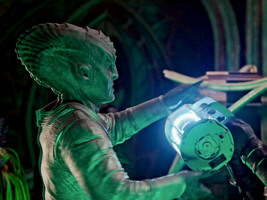
 L'Rell and Kol in DIS: "The Butcher's Knife Cares Not for the Lamb's Cry"
L'Rell and Kol in DIS: "The Butcher's Knife Cares Not for the Lamb's Cry"